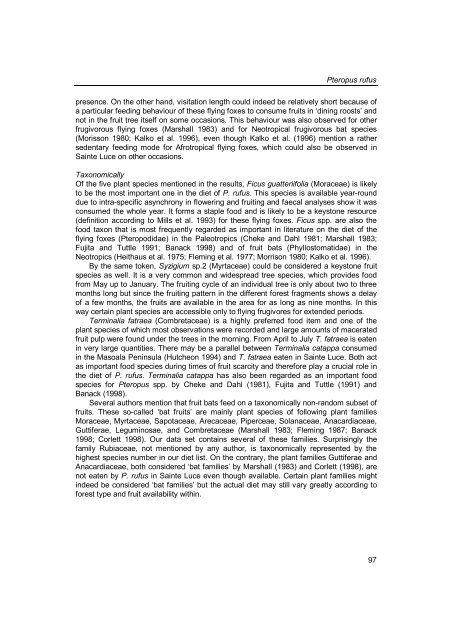Fruit-frugivore interactions in a Malagasy littoral forest - Universiteit ...
Fruit-frugivore interactions in a Malagasy littoral forest - Universiteit ...
Fruit-frugivore interactions in a Malagasy littoral forest - Universiteit ...
Create successful ePaper yourself
Turn your PDF publications into a flip-book with our unique Google optimized e-Paper software.
Pteropus rufus<br />
presence. On the other hand, visitation length could <strong>in</strong>deed be relatively short because of<br />
a particular feed<strong>in</strong>g behaviour of these fly<strong>in</strong>g foxes to consume fruits <strong>in</strong> ‘d<strong>in</strong><strong>in</strong>g roosts’ and<br />
not <strong>in</strong> the fruit tree itself on some occasions. This behaviour was also observed for other<br />
frugivorous fly<strong>in</strong>g foxes (Marshall 1983) and for Neotropical frugivorous bat species<br />
(Morisson 1980; Kalko et al. 1996), even though Kalko et al. (1996) mention a rather<br />
sedentary feed<strong>in</strong>g mode for Afrotropical fly<strong>in</strong>g foxes, which could also be observed <strong>in</strong><br />
Sa<strong>in</strong>te Luce on other occasions.<br />
Taxonomically<br />
Of the five plant species mentioned <strong>in</strong> the results, Ficus guatteriifolia (Moraceae) is likely<br />
to be the most important one <strong>in</strong> the diet of P. rufus. This species is available year-round<br />
due to <strong>in</strong>tra-specific asynchrony <strong>in</strong> flower<strong>in</strong>g and fruit<strong>in</strong>g and faecal analyses show it was<br />
consumed the whole year. It forms a staple food and is likely to be a keystone resource<br />
(def<strong>in</strong>ition accord<strong>in</strong>g to Mills et al. 1993) for these fly<strong>in</strong>g foxes. Ficus spp. are also the<br />
food taxon that is most frequently regarded as important <strong>in</strong> literature on the diet of the<br />
fly<strong>in</strong>g foxes (Pteropodidae) <strong>in</strong> the Paleotropics (Cheke and Dahl 1981; Marshall 1983;<br />
Fujita and Tuttle 1991; Banack 1998) and of fruit bats (Phyllostomatidae) <strong>in</strong> the<br />
Neotropics (Heithaus et al. 1975; Flem<strong>in</strong>g et al. 1977; Morrison 1980; Kalko et al. 1996).<br />
By the same token, Syzigium sp.2 (Myrtaceae) could be considered a keystone fruit<br />
species as well. It is a very common and widespread tree species, which provides food<br />
from May up to January. The fruit<strong>in</strong>g cycle of an <strong>in</strong>dividual tree is only about two to three<br />
months long but s<strong>in</strong>ce the fruit<strong>in</strong>g pattern <strong>in</strong> the different <strong>forest</strong> fragments shows a delay<br />
of a few months, the fruits are available <strong>in</strong> the area for as long as n<strong>in</strong>e months. In this<br />
way certa<strong>in</strong> plant species are accessible only to fly<strong>in</strong>g <strong>frugivore</strong>s for extended periods.<br />
Term<strong>in</strong>alia fatraea (Combretaceae) is a highly preferred food item and one of the<br />
plant species of which most observations were recorded and large amounts of macerated<br />
fruit pulp were found under the trees <strong>in</strong> the morn<strong>in</strong>g. From April to July T. fatraea is eaten<br />
<strong>in</strong> very large quantities. There may be a parallel between Term<strong>in</strong>alia catappa consumed<br />
<strong>in</strong> the Masoala Pen<strong>in</strong>sula (Hutcheon 1994) and T. fatraea eaten <strong>in</strong> Sa<strong>in</strong>te Luce. Both act<br />
as important food species dur<strong>in</strong>g times of fruit scarcity and therefore play a crucial role <strong>in</strong><br />
the diet of P. rufus. Term<strong>in</strong>alia catappa has also been regarded as an important food<br />
species for Pteropus spp. by Cheke and Dahl (1981), Fujita and Tuttle (1991) and<br />
Banack (1998).<br />
Several authors mention that fruit bats feed on a taxonomically non-random subset of<br />
fruits. These so-called ‘bat fruits’ are ma<strong>in</strong>ly plant species of follow<strong>in</strong>g plant families<br />
Moraceae, Myrtaceae, Sapotaceae, Arecaceae, Piperceae, Solanaceae, Anacardiaceae,<br />
Guttiferae, Legum<strong>in</strong>osae, and Combretaceae (Marshall 1983; Flem<strong>in</strong>g 1987; Banack<br />
1998; Corlett 1998). Our data set conta<strong>in</strong>s several of these families. Surpris<strong>in</strong>gly the<br />
family Rubiaceae, not mentioned by any author, is taxonomically represented by the<br />
highest species number <strong>in</strong> our diet list. On the contrary, the plant families Guttiferae and<br />
Anacardiaceae, both considered ‘bat families’ by Marshall (1983) and Corlett (1998), are<br />
not eaten by P. rufus <strong>in</strong> Sa<strong>in</strong>te Luce even though available. Certa<strong>in</strong> plant families might<br />
<strong>in</strong>deed be considered ‘bat families’ but the actual diet may still vary greatly accord<strong>in</strong>g to<br />
<strong>forest</strong> type and fruit availability with<strong>in</strong>.<br />
97

















